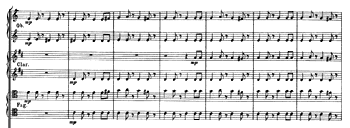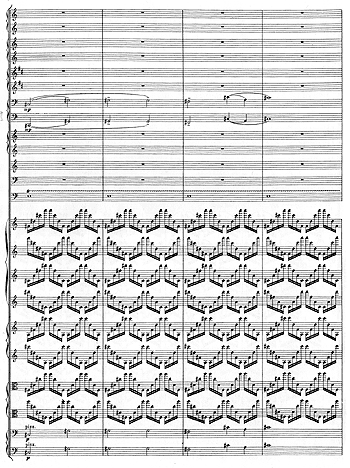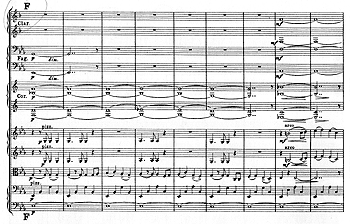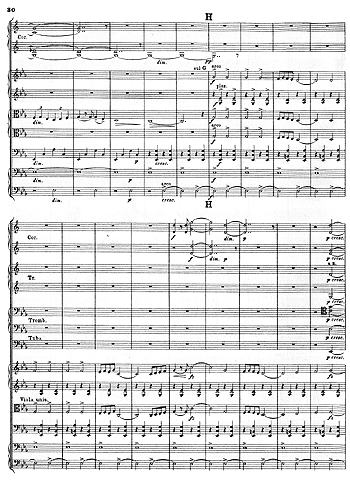Op. 9 En Saga, symphonic poem for orchestra.
First version 1892; first performance in Helsinki, 16th February 1893 (Orchestra of the Helsinki Orchestra Society under Jean Sibelius). Final version 1902; first performance in Helsinki, 3rd November 1902 (Orchestra of Helsinki Philharmonic Society under Robert Kajanus).
In the spring of 1892 Robert Kajanus reminded Sibelius that the massive forces needed to perform Kullervo would limit the possibilities of performing the work. He now hoped that the composer would write a small orchestral work which could be used more flexibly.
Sibelius did indeed start work on a new orchestral composition. In Vienna in 1891 he had already been planning an octet or a septet and later he worked on "Scène de Ballet no. 2". It is possible that the new orchestral work began to take shape from the material in these drafts. Sibelius was writing En Saga at Monola House near Lieksa, immediately after his wedding. Composition was interrupted in 1892, when he set out to collect traditional poems and songs, but was continued at the first family apartment in Helsinki in the autumn of 1892. He completed the work in December.
En Saga did not end up as a small work; in its original version it is a large-scale orchestral poem lasting over 20 minutes. The musicians of Kajanus's orchestra found the work as incomprehensible as Kullervo had been and some members of the orchestra were in favour of refusing it. This was unacceptable to Kajanus, and the composition was performed on 16th February 1893. Sibelius conducted En Saga himself, while Kajanus took care of the rest of the programme. The reception was quite different from that of Kullervo. Many people wondered what En Saga was really about. Sibelius never explained the programme of his work - if there was any. To him En Saga was "an expression of a state of mind":
"En Saga is psychologically one of my most profound works. I could almost say that the whole of my youth is contained within it. It is an expression of a state of mind. When I was writing En Saga I went through many things that were upsetting to me. In no other work have I revealed myself as completely as in En Saga. For this reason alone all interpretations of En Saga are, of course, completely foreign to my way of thinking."
The critic Karl Flodin found the work puzzling. "If only his musical intuition were a little less capricious," he complained. Oskar Merikanto suggested that Sibelius could cut out certain superfluous parts of the work. Sibelius did in fact do this in 1902.
En Saga is an introduction to Sibelius's way of dealing with symbolism. It is no coincidence that in a letter to Adolf Paul he mentions Böcklin's paintings in the same sentence as En Saga.
En Saga is also a Finnish work. The atmosphere of the original version brings to mind Kalevala. As late as 1921, in an interview with A. O. Väisänen, Sibelius himself associated the atmosphere of the work with Finland.
"In that work we are on familiar ground. How could one think of anything other than Finland while listening to it! I wrote the beginning of this work in Vienna and I continued it in Lieksa, at Monola, where we spent the late summer of 1892. [The Sibeliuses were in Lieksa from around 15th June to around 15th July] The fact is that the place where it was written does not affect the character of En Saga. I have never been as Finnish as I was in Vienna, Italy and Paris, and never as Parisian as I was in Pielisjärvi."
Thus Sibelius emphasised to Väisänen the Finnish character of En Saga. Several decades later he found the atmosphere of the composition to be closer to the ancient Icelandic poems of the Edda than to Kalevala. However, the remark from 1921 may be closer to Sibelius's thoughts during the actual composition of En Saga.
To the annoyance of Robert Kajanus and Aino Sibelius, Sibelius decided to revise the work in 1902. "I like and have always liked the first version. Papa removed some violent passages from it. Now En Saga is more civilised, more polished," Aino Sibelius complained in her old age. In practice "civilisation" showed itself as more thorough integration of the material, fewer tempo changes and modulations and improved instrumentation. Sibelius also removed the extensive pastoral middle section. This had contained his most modern musical language so far, including seventh inversions of ninths, proceeding in parallel motion.
Kajanus conducted the new version of En Saga in Helsinki on 2nd November 1902. Merikanto was still not enthusiastic:
"It is also an undeniable fact that the composition as a whole makes a melancholy, unhealthy impression despite its improvements. But this is after all a 'saga', a fiction which should not be taken as reality. Consequently, it is good to see the extent to which Sibelius has developed in his later works - mainly in his two symphonies. He has become healthy and found a consistent style."
In Uusi Suometar, Evert Katila was more sympathetic. "What is new in the later form of the work is its greater concentration, several powerful crescendos and a more excellent use of the horns," was his analysis.
Sibelius went to Berlin to conduct the new version with the Berlin Philharmonic Orchestra in the same year, 1902. The concert was a great success, and most of the critics praised the work. I was called [to take a bow] five (?) times. The main thing is that I can conduct a world-class orchestra. And I can do it well! That's what everybody said!" Sibelius wrote to Aino on 16th November.
He was already demonstrating his brilliance as a composer. Both in its 1893 and its 1902 versions En Saga begins with a dreamlike figure from the strings. Soon after this the woodwinds play a lumbering, troll-like theme.

Excerpt from page 2 of the score of En Saga.
Breitkopf & Härtel.
Musicologists are undecided about which is the main theme and which the secondary theme of the work. However, already in these early bars of the work there are rhythms and repetitions which belong to the central thematic material.
Soon after this the two versions differ from each other. The original version is 952 bars long, whereas the final version is 810 bars in length. The original version is also fresher and more primitive, more fragmentary and heterogeneous. The final version is, nevertheless, more consistent. The thematic material is introduced more clearly, first of all from the bassoons, in C sharp minor.

Page 6 of the score of En Saga.
Breitkopf & Härtel.
The French horns join in while the strings continue their will-o'-the-wisp figuration in the background. The main theme, which has already been anticipated in the slower introduction, is presented in an allegro episode. After a powerful orchestral climax we hear important thematic material from the violas; this has been referred to as a subtheme. Its relationship with the theme presented by the bassoons is unmistakable.

Excerpt from page 26 of the score of En Saga.
Breitkopf & Härtel.
There is yet a third theme which is very closely connected with those mentioned above. The musicologist Salmenhaara was unsure whether this should be called a final theme or merely a second subtheme. It is introduced by the violins.

Page 30 of the score of En Saga.
Breitkopf & Härtel.
Here we have the central thematic material from which Sibelius compiled his En Saga. Sibelius varies and develops his thematic material rather in the manner of Finnish rune-singers. In the original version there is even more thematic material, but in the later version the composition makes a stronger impression, compelled by its own inner logic. There are a few discontinuities in the original version, but the final version is an organic whole.
Tonally speaking, En Saga is an adventurous work; it begins in A minor and ends in E flat minor. Robert Layton has pointed out that
even at this early stage in Sibelius's career En Saga is masterly in its handling of the orchestra. Sibelius shows himself to be a genuine orchestral composer in the manner of Berlioz. These conceptions could not originate at the piano or by orchestrating a piano
version. In its 1902 version
En Saga quickly charmed the rest of the world, and Arturo Toscanini and Henry Wood added it to their repertoires. Even today, En Saga is one of Sibelius's most popular and most frequently recorded orchestral works

